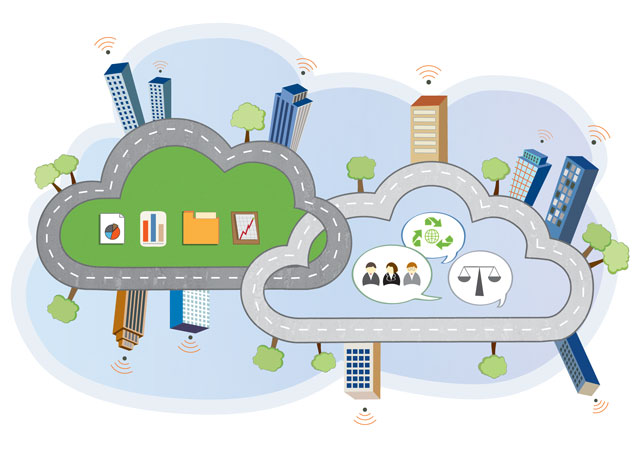By Kyle Armbrester and Robert G. Eccles
A sustainable strategy is best reinforced through integrated reporting, a new management practice based on an integrated presentation of financial and nonfinancial (e.g., environmental, social, and governance) performance. Through cloud computing, integrated reporting can be easily and inexpensively adopted by companies of all sizes, thereby contributing to the development of a sustainable society.
Global concern continues to grow about how to create a sustainable society, one which can meet the needs of the presentation generation, including fulfilling the aspirations of the billions of people in developing countries without compromising the ability of future generations to meet their own needs. There are a number of challenges to creating a sustainable society. Externalities created by companies’ operations and products (e.g., CO2 emissions contributing to climate change and pollution resulting from waste) reduces the quality of human life and can ultimately threaten its very existence. Over-consumption of nature resources (e.g., certain plants and minerals, water, land, and ocean life) puts the viability of future generations at risk. Social injustice (e.g., wages and working conditions in developing countries in factories that are part of the supply chain of large multinational companies) eventually leads to social unrest and class conflict. Finally, dysfunctional capital markets that destroy value (e.g., financial products that are divorced from the real economy and excessive risk taking by large financial institutions) erode investor confidence and put severe strains on the political and social system, especially when the few people participate in all the financial benefits of the upside, and society as a whole bears the financial cost of the downside.
In order to address these issues, companies can no longer simply focus on financial results that create value for shareholders whatever the expense to other stakeholders (e.g., employees, suppliers, and the communities in which they operate). Instead, they must also focus on their environmental, social, and governance (ESG) performance – which we will refer to as nonfinancial performance – and understanding the relationship between financial and nonfinancial performance. This can be done through “integrated reporting,” a simple but powerful new concept that will enable companies and investors to make resource allocation decisions that will contribute to creating a more sustainable society.1 Integrated reporting is the most effective way to communicate and reinforce a sustainable strategy, defined as one that creates value for shareholders over the long term while contributing to a sustainable society.
[ms-protect-content id=”9932″]In its simplest terms, integrated reporting involves combining material information on a company’s financial and nonfinancial performance, while also describing their relationship between these performances, in a single document. Although relatively few companies are practicing integrated reporting today, those doing so include the Brazilian cosmetics and fragrances company Natura2, the Danish pharmaceutical company Novo Nordisk3, the Dutch healthcare and lighting company Philips, the German chemical company BASF, and, in the United States, such companies as American Electric Power, Pfizer, Southwest Airlines, and United Technologies Corporation. South Africa now requires all companies listed on the Johannesburg Stock Exchange to provide an integrated report or explain why they are not doing so.4 In all other countries, integrated reporting is a purely voluntary practice. The International Integrated Reporting Committee (IIRC) has developed a draft framework for integrated reporting that is now being tested in a pilot program.5 More recently, the Sustainability Accounting Standards Board (SASB) was founded to develop industry-specific key performance indicators for nonfinancial information that are material for investors.6
Momentum is building for integrated reporting due to a combination of market and regulatory forces that promise to make this the “best practice” in corporate reporting. But time is limited for creating a sustainable society. Sustainable strategies and the practice of integrated reporting must become rapidly adopted by most – and ideally all – of the world’s companies, both large and small. In this article, we will make the case that the technology of cloud computing has a central role to play in making this happen. Cloud Computing Most of the business community, and especially the IT sector, is talking about the benefits of “going to the cloud” and companies are touting the scalability, compatibility, and interoperability benefits of cloud computing. While the general concept, transforming computing from in-house hardware and software assets owned by the company to a service-oriented platform purchased on a usage basis – such as per transaction or a monthly license fee within some limits – is becoming increasingly more commonplace, the true benefits of its robust application are only now being realized, especially for corporate reporting applications.
There are two broad categories of cloud computing: public and private. In the public version, a company shares computing capacity with other companies, although with security arrangements to ensure that only people that are authorized to see the company’s data have access to it. Shared computing capacity lowers per unit costs since it balances out times of heavy usage by one group with times of lower usage by another. Common examples are salesforce.com or online banking sites that have shared hosting environments where Software as a Service (SaaS) applications are delivered. In the private version, the company has its own dedicated servers, although the physical hardware and software is still hosted by the service provider from whom the company purchases capacity on an as-needed basis; no shared resources are leveraged in this private version.
Historically, companies and other organizations have had massive and complex enterprise resource planning (ERP) systems that were installed centrally and resulted in substantial overhead and challenging data management issues. These are an even bigger issue when these systems need to be integrated, typically due to merger and acquisition activity, and when new data standards or management processes need to be embedded in these systems. Cloud-based computing enables software, storage, and data access to be provided without a defined physical facility or detailed configuration of a complex system that governs the services being provided.
Integrating new data, new data standards, and new management processes largely become the responsibility of the cloud service provider, and thus can be managed and distributed from one central location. Most companies providing this service have deep expertise in information technology (far deeper than any single organization) and can take advantage of both scale and scope in order to reduce costs, improve flexibility, and speed IT systems’ adaptation to changing circumstances.
Cloud computing makes possible a truly integrated viewpoint on a company’s business practices. Unlike traditional “hard asset” systems where sharing data across systems is difficult and often virtually impossible, cloud computing enables companies to push their data and reporting capabilities onto a platform that promotes comparability of key performance indicators, standardization of measurement, and broad availability with specific security and access rights. This enables easy sharing of data across functions and business units in the company in order to compare performance, creating incentives and insights for the poorer-performing units to do better.
Cloud computing also enables comparability across companies for similar benchmarking purposes. A company will have complete access to its own data which it can compare to deidentified data of a broad group of other companies, where all companies are reporting to the same set of standards and business processes. The company can also make the performance data it wishes to share externally available to shareholders and other stakeholders using higher levels of security to provide deeper levels of access.
The Role of the Cloud in Integrated Reporting
Companies interested in adopting the practice of integrated reporting face three major challenges: (1) the lack of an agreed-upon framework for the content of an integrated report and the lack of a set of measurement and reporting standards for nonfinancial information, (2) largely inadequate internal measurement and control systems for non-financial information and the difficulty of consolidating all the financial and nonfinancial information that needs to be included, and (3) a good understanding of the relationship between financial and nonfinancial performance. Cloud computing cannot directly solve the first problem, although it can contribute to the rapid adoption of frameworks and standards when they are developed by using them in the design of their service offering. As the number of customers using cloud computing services increases, these frameworks and standards will spread. Of course, ideally there will be a single underlying framework (such as the one being developed by the IIRC) and set of standards (such as the industry-specific KPIs being developed by SASB) which are adapted to a company’s particular situation. Collaboration and buy-in are critical here, because competing standards will only interfere with interoperability, slow the growth of the market, and result in suboptimal outcomes resulting from the lack of scalability of platforms.
The second challenge, inadequate internal measurement and control systems for nonfinancial information and integration of financial and nonfinancial performance measures, is a problem faced by even the largest and most sophisticated companies. Enterprise resource planning (ERP) systems for timely financial reporting are robust as vendors such as Oracle and SAP have developed software in response to regulations regarding financial reporting, based on a strong set of accounting standards. As discussed above, few regulations exist regarding nonfinancial reporting, let alone integrated reporting and, as a result, systems supporting this process are largely undeveloped. This undoubtedly will change as frameworks and standards are developed and regulations are put in place for using them. However, the likely result will simply be an increase in the number of boutique companies offering specialized solutions, such as for carbon emissions or supply chain monitoring, and a few large vendors, such as SAP, have developed niche applications.7 This outcome of increasing vendor fragmentation is especially likely if regulations are disclosure-specific. Such regulations will improve the quality of nonfinancial information reported to investors and other stakeholders, but they will not address the integration problem. In fact, they will make it even worse, and thus it would be much better to have regulation which mandates integrated reporting.
Currently there is no software package that pulls together all of a company’s relevant nonfinancial information. As a result, this information is distributed throughout the company’s many functions and business units, residing in specialized software solutions and spreadsheets. Southwest Airlines found this to be the case when it decided to produce its first integrated report.8 The seemingly prosaic task of simply “closing the nonfinancial books” at the same time as the financial books remains one of the largest barriers to producing a timely integrated report. While a nonfinancial ERP system could certainly be developed, companies would then be confronted with the time and cost of installing it and ensuring that it was integrated with the existing complex financial reporting system software in order to produce an integrated report. Alternatively, vendors selling financial reporting systems could add nonfinancial information requirements. However, it is likely that the level of complexity that would be added to these already massively complex financial reporting systems would make the product unwieldy and technically unstable.
Companies are increasingly moving away from large hardware and licensed software (usually both with large maintenance and support contracts) purchases for “on-premise” use and shifting many of their IT needs to cloud-based providers, via shared hosting and SaaS delivery platforms. With integrated reporting there is an opportunity to start with the cloud in the first place, avoiding the integration problems of newly installed software and the complexity problems that come from a single ERP system for financial and nonfinancial information. The cloud computing-based SaaS vendor will work with the company to ensure that the necessary data capture mechanisms and processes are in place so that it can gather all relevant nonfinancial information into a hosted application, including whatever variation is necessary according to variables such as size, sector, and geography. The vendor can also integrate this nonfinancial information with the necessary financial information, either taking the required financial data from internal systems or moving this functionality to the cloud as well.
The benefits of a cloud computing approach are enormous. Companies can start incrementally, integrating a small number of metrics for nonfinancial performance for which they have the greatest confidence about their materiality and rigor of the measures, and pay only for the computing capacity necessary to do this. As their sophistication grows and more metrics are added, cloud computing provides a seamless way to scale the application on a continuous cost curve, avoiding major step-change investments in new hardware and software and other necessary upgrades that would otherwise be required in an “on-premise” environment. Similarly, the SaaS business model enables companies to incrementally add functions and business units contributing data to the integrated report.
The low cost, incremental economics of cloud computing makes it possible for even the smallest companies to practice integrated reporting. The larger the number of companies practicing integrated reporting, the more sustainable our society will be. By making it easy for any company to implement integrated reporting, cloud computing has a direct contribution to creating a more sustainable society that goes far beyond the significant energy savings from computer usage often touted as a benefit to cloud computing.9
Cloud computing can also play an important role in enabling integrated reporting in a company’s supply chain through the use of a private cloud application. In a number of industries – such as shoes and apparel manufacturing, retail distribution, telecommunications, and computers and electronic equipment – the company’s ESG performance is heavily dependent on the performance of the hundreds, and often thousands or even tens of thousands, of companies in its supply chain. How well these supply chain members are managing their use of natural resources, adhering to regulations and best practices regarding wages and working conditions, and practicing good risk management has a significant effect on the performance of the company itself. Through cloud computing, a company makes it easy for all of its supply chain members to provide it with integrated reports, which it can then aggregate into an overall integrated report for the company itself. Since many supply chain members are small and medium-sized enterprises (SMEs), the low and incremental cost nature of a SaaS integrated reporting offering eliminates the cost barrier to them providing the desired information. The company can use a private cloud to enable supply chain members to benchmark their performance against each other, creating internal competition to spur performance improvements.
The third challenge, and the most significant one for developing a sustainable society, is an empirically confirmed understanding of the relationship between financial and nonfinancial performance. A growing number of companies are making the broad and sweeping claim that “ESG is good for shareholders,” ignoring the fact that difficult tradeoffs often exist, but very little information is given to support the claim. While some companies do cite the low-hanging fruit of how improved energy efficiency simultaneously reduces costs and CO2 emissions, very little is said about how good ESG performance contributes to such financially relevant outcomes as lower costs, increased revenues, reduced risk, more engaged employees, greater customer loyalty, a more efficient supply chain, and a more stable base of long-term investors. While companies can be more rigorous in formulating hypotheses about the cause-and-effect relationships between financial and nonfinancial performance, validating these hypotheses requires data and these can be easily made available through a cloud-based application that aggregates data from a large number of companies.
Here too the cloud and SaaS can help, and especially when nonfinancial information is reported according to a set of standards. Cloud computing makes it possible to aggregate the performance results of a large number of companies, providing a database that all companies using the same vendor can access. Not only can a company benchmark its performance against a set of peers – defined in terms of sector, geography, size, and other dimensions – but it can also use this very rich aggregate database to test hypotheses about the relationship between financial and nonfinancial performance. Conceivably, the cloud computing vendor can include a social media platform in its service offering through which peers in different companies can share hypotheses, analysis, and best practices regarding processes for managing nonfinancial performance to the extent they care to do so. While companies will obviously not disclose proprietary information, all industries have forums for improving management practices. Cloud computing for integrated reporting provides an efficient and cost-effective web-based platform for doing so. The same can be done with a private cloud application in the company’s supply chain.
From Integrated Reports to Integrated Reporting
Companies can benefit from the web more generally, as most are already doing so by providing more and more functionality on their corporate website. For most people, the word “reporting” connotes documents. After all, Annual Reports are documents, as are required filings for public companies, such as the 10K in the United States. Using the Internet to post a PDF version of a company’s integrated report is a useful but modest way to leverage the capabilities of the web. The company can use its website to provide more detailed data of interest to particular stakeholders that goes beyond the nonfinancial information that is material to investors that is part of the integrated report. It can also provide interactive tools for analyzing this information, along with information from other sources of interest to the user. Other ways to leverage the Internet, as Philips is doing, include enabling users to put together their own customized report, to provide data views customized to the user (such as financial analyst, sustainability analyst, or employee), and to provide data in other formats such as videos by key company executives.10 Another interesting application, used by Novo Nordisk, is interactive games which illustrate the complexities and trade-offs in creating a sustainable strategy whose results are provided in an integrated report.11
Going beyond these particular applications, we envision a future where the emphasis is not on an integrated report but on integrated reporting through an integrated website where information can be updated on a real-time basis, where data representations and applications can be tested and improved or discarded, and where shareholders and stakeholders can provide feedback on the company’s reporting practices. This dynamic approach enables a higher level of engagement between a company and all of its stakeholders, including shareholders, thereby ensuring that it has a sustainable society and improving the quality of its integrated reporting. In getting to this future, some companies may choose to start with the integrated report itself and use this as the basis for a more integrated and dynamic reporting website. Other companies may choose to do the reverse, starting with a more incremental approach to integrated reporting and then, when they are ready, producing an integrated report.
In either case, cloud computing will play an important role. It will enable companies to produce the data necessary for an integrated report and it will host the real-time data, applications, interactive tools, and social media for gathering feedback from users for integrated reporting. Cloud computing will make possible better reports and better reporting to support companies’ sustainable strategies for a more sustainable society.
About the authors
Kyle Armbrester is co-founder and CEO of Glenelg Partners, a boutique consulting firm focused on helping companies understand and adopt integrated reporting practices. Prior to founding Glenelg Partners, Kyle worked in the IT sector for 10 years on various strategy and integration projects, with a primary focus on web services and big-data problems. Kyle holds an AB in Political Theory from Harvard College and will be graduating from Harvard Business School with his MBA in June 2012.
Robert G. Eccles is a Professor of Management Practice at the Harvard Business School where he teaches MBA and executive education courses on “Innovating for Sustainability” and a doctoral seminar on “The Role of the Corporation in Society.” He is the author of numerous cases, articles, and books on corporate reporting. Eccles is co-founder and Chairman of Glenelg Partners and Chairman of the Sustainability Accounting Standards Board. He earned his S.B. in Mathematics and S.B. in Humanities and Social Science from the Massachusetts Institute of Technology in 1973 and his A.M. and Ph.D. in Sociology from Harvard University in 1975 and 1979, respectively.
Notes
1. For more information on integrated reporting, see One Report: Integrated Reporting for a Sustainable Society, by Robert G. Eccles and Michael P. Krzus, John Wiley & Sons, Inc., New York: 2010. For a recent update on the state of integrated reporting today see Eccles, Robert G. and George Serafeim. “Accelerating the Adoption of Integrated Reporting Accelerating the Adoption of Integrated Reporting.” Chap. 2.2 of CSR Index, edited by Francesco de Leo and Matthias Vollbracht, 70-92. INNOVATIO Publishing Ltd., 2011.
2. “Natura Cosmeticos, S.A.,” by Robert G. Eccles, George Serafeim, and James Heffernan. Harvard Business School Case N9-312-052, Nov. 6, 2011
3. “Novo Nordisk: A Commitment to Sustainability,” by Robert G. Eccles and Michael P. Krzus. Harvard Business School Case N9-412-053, Oct. 3, 2011.
4. South African Institute of Chartered Accountants, “An integrated report is a new requirement for listed companies.” Online: www.saica.co.za/tabid/695/itemid/2344/An-integrated-report-is-a-new-requirement-for-list.aspx.
5. http://www.theiirc.org/, accessed Nov.2011.
6. http://www.sasb.org/, accessed Nov. 2011. 7. SAP Carbon Impact On Demand, http://www.sapcarbonimpact.com/
8. “Southwest Airlines One Report™,” by Robert G. Eccles, Beiting Cheng, and Susan Thyne. Harvard Business School Case 9-411-042, Rev. Oct. 7, 2010.
9. See, for example, “Carbon Disclosure Project Study 2011, Cloud Computing-The IT Solution for the 21st Century,” https://www.cdproject.net/Documents/Cloud-Computing-The-IT-Solution-for-the-21st-Century.pdf, accessed Nov. 2011.
10. http://www.annualreport2010.philips.com/, accessed Nov. 2011.
11. http://www.novonordisk.com/sustainability/games/interactive-challenges.asp, accessed Nov.2011.
[/ms-protect-content]




























